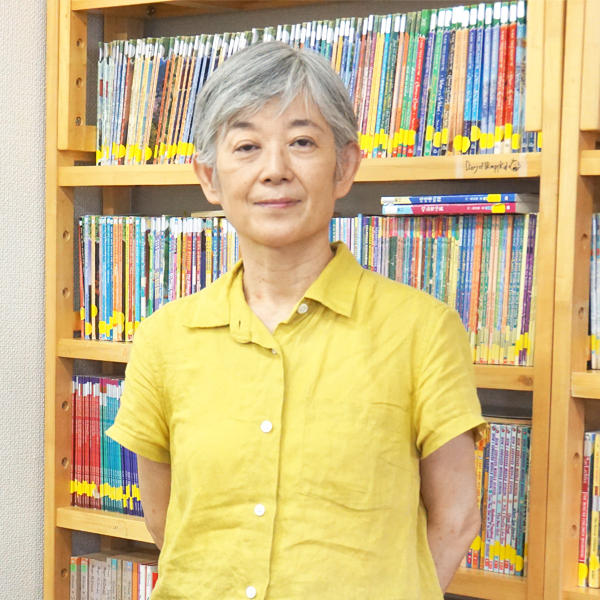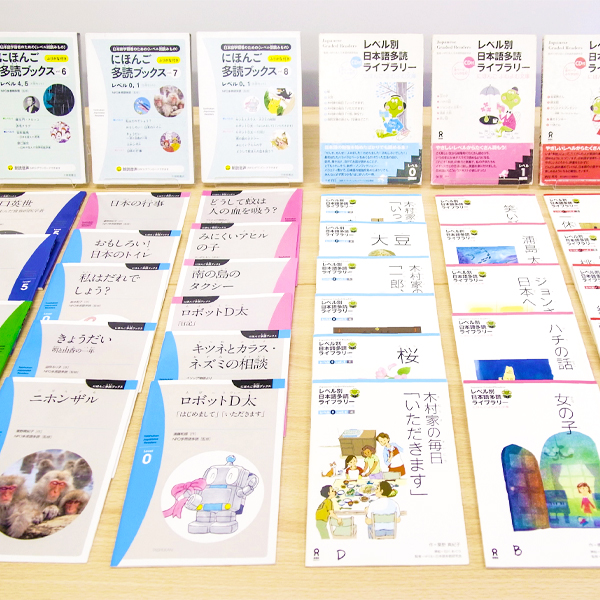Close UP
TADOKU Supporters - Popularizing Tadoku, a method to learn a language starting with simple picture books -
*This article originally appeared on a website operated by Tokyo International Communication.
In Close Up this month we introduce TADOKU Supporters. Tadoku is a fun learning method that permits anyone to learn a foreign language without resorting to memorization of words or grammar study. What is important is to choose a book that interests you and input as many words as possible in your head. Beginning with simple picture books and gradually moving up to books with a few more words, allows a person to eventually be reading paperback novels. The NPO, TADOKU Supporters, offers TODOKU English Courses to Japanese speakers, TADOKU Japanese Classes to foreigners, and organizes activities to promote the Tadoku method. We asked Presidint Makiko Awano to expound on the activities of TADOKU Supporters and the methods practiced by Tadoku.

Please tell us what led to the establishment of the organization to popularize the Tadoku method.

the Tadoku method of instruction after questioning the method
of teaching English in Japan.
TADOKU Supporters
Ms. Awano
Tadoku originally began abroad as a method to learn English. In the early 2000s, Kunihide Sakai, my partner who later became president of TADOKU Supporters, advocated that the Tadoku method be introduced in Japan to teach English. Being an English professor, Sakai questioned traditional learning based on reading comprehension, involving the reading of difficult phrases and translating them with the help of dictionaries. As a Japanese language teacher, I also had similar awareness. Soon after Sakai introduced the Tadoku method at the university where he taught, in 2002 I established a voluntary organization, the Study Society of Tadoku to Learn Japanese, with my Japanese language colleagues to launch activities to promote learning Japanese using the Tadoku method. We became a non-profit organization in 2006 in order to publish Japanese books exclusively for Tadoku and in 2012, after Sakai retired from university, we combined forces to join with Sakai´s activities to promote the Tadoku method to learn English under the new name, TADOKU Supporters.
Can you tell us of the group's current activities?
Ms. Awano
We have three mainstay activities. The first is the creation of books exclusively for Tadoku aimed at people learning Japanese. We elaborate and publish books with phonetic guides in hurigana, illustrations, and recorded text of various levels which allows readers to begin at an easy level and gradually move up to higher levels. There are many Tadoku books in English, but only by producing books ourselves can we acquire Tadoku books in Japanese of different levels. The second is to promote opportunities to practice the Tadoku method. We regularly organize Tadoku English Courses for Japanese and Tadoku Japanese Classes for foreigners. For foreign residents we also host the Japanese Book-Reading Club which takes place at the Shinjuku Multicultural Plaza. This activity has been suspended for a protracted period due to Covid 19, but we plan to resume on October 3. In addition to these activities we also organize gatherings to enjoy Tadoku in Spanish and in Korean. The last of the mainstay activities is to help expand the Tadoku circle, such as lectures, workshops held in libraries, free events to experience Tadoku in English, as well as developing our website to present varied information about Tadoku.

Taishukan Japanese Readers (Taishukan Publishing) are written and supervised by TADOKU Supporters.
TADOKU Supporters
How does one practice the Tadoku method?

TADOKU Supporters
Ms. Awano
Tadoku begins by using picture books without text so one can capture the story by viewing the illustrations. Gradually picture books with text are introduced, first one word per page, then two words per page, then three and four etc., each time increasing the number of words. At the same time, one listens to the audio of the text so as to learn many words, and the reader reflects, "Oh, this is how to describe in words the situation shown in the illustration", "The word is written like this" etc. In this way, by reading many books and gradually increasing levels, one acquires the ability to read books without the aid of illustrations, and to ultimately enjoy children's books and paperbacks. With Tadoku one can understand the background of a word, such as context and feelings associated with it, which makes it possible to naturally grasp the word as if it were in your native language.
Are there any techniques unique to Tadoku?
Ms. Awano
If we take Tadoku in English for example, there are Three Principles of Tadoku: (1) Do not consult a dictionary; (2) Skip over the parts not understood; and (3) Abandon the book if you feel it is not for you. That is to say, the correct way to follow Tadoku is not to invest time looking up words but to advance rapidly in the book skipping over parts you don't understand, and if you still don't enjoy the book move on to another book. The most important thing is to read as many books that you enjoy as possible. It is not necessary to force yourself to read books that are too difficult or that don't interest you. You may think that by not looking up a word in a dictionary its meaning will never be clear. But by encountering the same word in many books you will gradually grasp the meaning of the word without intervening with its Japanese definition. The Tadoku method of learning is also very effective for persons who know some English and want to improve it. By beginning with simple books and gradually moving up the levels, bit by bit you will understand English without thinking in Japanese---and that will change your world.

TADOKU Supporters
What comments are left by participants of the English TADOKU Courses and Japanese TADOKU Classes?

TADOKU Supporters
Ms. Awano
The most frequent comments by participants of English Tadoku Courses are: "Before even realizing it I was able to read different kinds of books", and "I began studying English but now so enjoy reading picture books that I can't stop attending the course". They also tell us, "My speaking improved" and "I am now good at writing", etc. The four skills of reading, writing, listening and speaking are interconnected, therefore it should come as no surprise that the words and expressions one has learned with the Tadoku method come out naturally. After all, many inputs create outputs. One participant in the Japanese Tadoku Class has attended for 9 years. This person, who was not very fluent in Japanese as he works in English, learned with Tadoku to read thin books and can now read flash fictions by Shinichi Hoshi, although with a hiragana phonetic guide. This person tells us he cannot stop coming to class because he feels there has been slow but steady progress.
Please tell us about any activities planned for the future.
Ms. Awano
Regarding Tadoku in Japanese, in addition to elaborating books exclusively for Tadoku as we have been doing, we would like to find more ordinary books appropriate for Tadoku in order to present people learning Japanese a great variety of interesting books. Tadoku in Japanese is an excellent way to learn kanji (Chinese characters) which poses a barrier to foreigners wanting to learn Japanese. Except for those placing maximum priority on conversation, we invite people who want to learn Japanese characters in order to live in Japan over the long term, to try Tadoku. Regarding Tadoku in English, we want to improve our online courses so as to let many people know about this fun learning method. Also, because Tadoku requires vast quantities of books, we are taking steps to disseminate Tadoku in Japanese and English in libraries so people can avail themselves to this resource. We say, "Tadoku, Tacho and Takan" (read lots, listen lots, and see lots) and recommend that in addition to reading books and listening to audio, people watch anime and videos. We want people to learn a language through the enjoyment of what they truly like and that is interesting to them.
